By Marsh Gelbart
Background
At the close of the Second World War the British army was in the invidious situation. Along with Canada and Australia it remained one of the few major combatants which still relied on bolt action rifles for its standard infantry weapon. The British had been aware of this shortcoming during the war. However, the pressing need to produce as many rifles as possible, precluded any shift to a more modern product mid-war. Post war there was a determination to rectify the situation, impetus being provided by the Cold War tensions and the conflict in Korea.
This situation led to the introduction of two experimental British battle rifles, known as the EM-1 and EM-2. Conceived in the late 1940s, they not only employed a futuristic Bullpup configuration, but also used an intermediate calibre round that matched the needs of infantry combat better than their competitors.

Inception
The British knew that they would have to change their ammunition type if they produced an automatic rifle. The rimmed .303 (7.7x 56mm) rounds used by their Short Magazine Lee Enfield, could not easily be used in a magazine fed self-loading weapon. The British had been greatly impressed during the closing months of the war, by new German assault rifles such as the MP 44. The MP 44 fired a 7.92mm x 33mm round known as the 7.92 Kurz, a cartridge lighter and more portable than the full power ones used by traditional battle rifles. This so-called intermediate calibre round gave acceptable terminal ballistic performance, whilst its lower weight allowed infantry to carry additional ammunition. The British decided to learn from German experience and investigated smaller calibre, rimless ammunition suitable for a new rifle. The intention was to produce a weapon as light, handy and compact as possible, firing rounds capable of killing an enemy out to a maximum range of 600 yards. The British Ministry of Supply initiated research to find the optimum calibre round, the Armaments Design Establishment coming up with a bullet of .270 (6.8mm) calibre which was reworked to .276 (7mm ) to make it slightly more in line with current American thinking. This round was renamed the .280, although in fact it retained a calibre of .276 mm.
The British developed two competing Bullpups, the EM-1 and EM-2, strikingly similar in appearance and each capable of firing their new round. The Bullpup configuration was adopted because it allowed a full-length barrel, a feature which assisted accuracy, in a weapon of short overall size.
Work on the EM-1 and EM-2 started in earnest in 1947. Weighing 10.25 lbs unloaded, the EM-1 was a well balanced weapon. The EM-1 was also known as the Thorpe rifle, after the head of the design team. Initially designed as a conventional weapon, the rifle was reworked to a Bullpup configuration in 1947. The EM-2, also known as the Janson rifle, weighed 7 lbs 13 oz unloaded. It was the EM-2 that Britain decided to develop into a service rifle. This was because the Thorpe rifle used stamped steel in its construction. This technique although widely employed in modern assault rifles, was not widely available in the Britain of the late 1940s. Consequently development of the EM-1 fell behind and efforts concentrated on the EM-2.
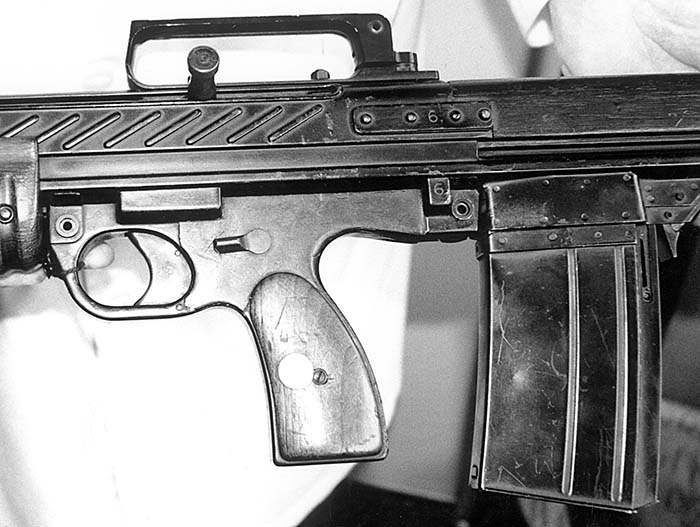
Layout and mode of operation
The British had played around with the concept of a Bullpup service rifle since 1944. Three rifles had proved influential.
- The Enfield experimental sniper’s rifle in 7.92 x 57 mm.
- An untried Bullpup concept known as the Harris rifle.
- The EM-1 Korsac LMG, a prototype weapon which was to heavily influence the later Bullpups.
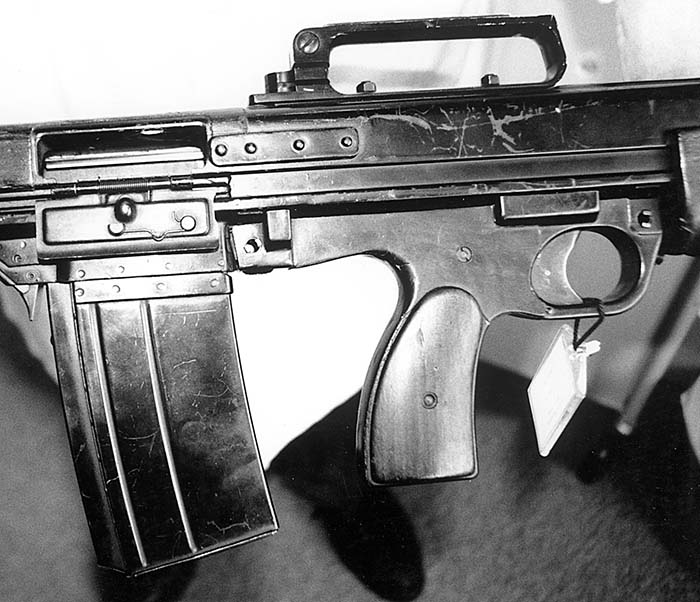
In brief the EM-1 and EM-2 were gas-operated, air-cooled rifles. The guns had a positively locked breech with forward locking. Both the EM-1 and EM-2 were optimised for semi-automatic fire but could also perform in the full automatic mode, either as rifles or by virtue of their handy size, as sub-machine guns. The weapons were fed by a well designed, sturdy magazine which held 20 rounds.
The magazine housing lay behind the rifles’ trigger group. The Bullpups didn’t have a conventional stock. Instead they had a rubber padded, steel butt. Both rifles had a wooden fore grip and pistol grip. The EM-1 had a traditional safety catch above and behind the left side of the pistol grip, operated by the right thumb. The EM-2 had a less conventional safety immediately ahead of the trigger guard, usually operated by the right index finger. There was an Arctic trigger guard available for cold weather operations when the soldier would be wearing gloves.
The trigger was not the EM-2’s best feature. There was no discernable first and second pressure for the trigger, the firer didn’t know when slack ended and firing pressure was reached. However, when fired, the rifle had little kick, recoil being taken up in a straight line. An optical sight was mounted on a bracket which acted as a carrying handle, greatly assisting accuracy. The sight’s concept was a generation ahead of its competitors, how was it implemented?
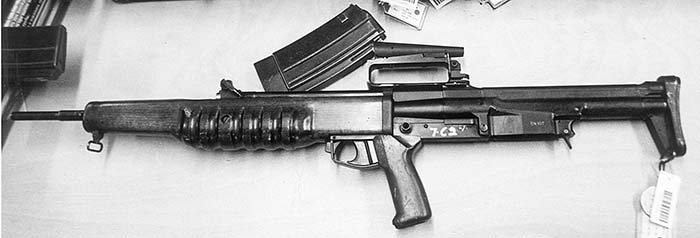
Sights
The new Bullpup rifles were intended from inception to have optical sights rather the standard iron sights usually fitted to infantry rifles. User manuals for the EM2 have illustrations of an early design optical sight, referred to as the Long Arm Sight. This was an optical tube attached to a rather clumsy mount. The optical tube could be moved into one of two positions. The first, the raised position, was to be used when action was imminent or when the soldier was drawing a bead on a target. When not in use, the sight was lowered by a flick of the finger into the down position. Once lowered, raised metal side-plates protected the sight. However, the rather delicate x1 magnification optical tube was not adequately protected from above, being vulnerable to mud and dirt being packed down in between the metal plates which protected the optical tube.
Not only was the Long Arm Sight vulnerable to abuse on the battlefield, it was overly complex. A particularly involved series of adjustments were required to accurately zero the rifle. The Long Arm Sight was fitted with a drum allowing compensation for vertical error. Initial coarse adjustments could be made using a screw which raised/lowered the optical tube. Manipulating two screws mounted in the elevation drum itself completed fine tuning the aim. Two screws mounted at the base of the sight were also employed to compensate for lateral deflection. It is hard not to come to the conclusion that the Long Arm Site was ill thought through. It was perhaps more suited to the type of long range engagement typical of the previous generation of infantry combat, not the fast moving, close range combat that the Bullpup was intended for.
In any event, a far simpler and more durable site was fitted to both the EM-1 and EM-2. This consisted of a fixed optical tube, attached to the weapon’s carrying handle. A cylindrical metal shroud protected the x1 magnification sight optics, shielding the lenses from all angles. Fitting thicker or thinner washers to two simple screws could compensate for vertical and lateral error. The adopted sight had an inverted pointer and range gradations etched on the lens. Auxiliary iron sights, consisting of a peep and blade, were fitted to the frame of the optical site for use in an emergency.
The EM-2 was also designed to carry a x 3.5 telescopic sight intended for sharp-shooting. The telescopic sight was locked into position on top of the carrying handle. Accuracy for both Bullpups, whatever sight was in use, could be improved by fitting an optional bipod. In combination, the telescopic sight and bipod gave a usable combat range of 800 yards.
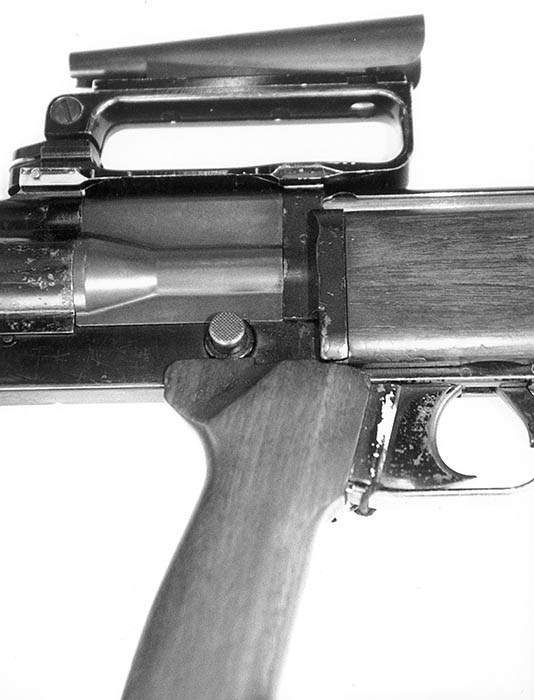
Handling and firing characteristics
The author has not fired the EM-1 or EM-2. However, as far as handling characteristics are concerned, both weapons seemed easy to bring to the aim and settled nicely into the shoulder. The author’s poor eyesight usually makes taking an accurate aim rather difficult. It proved much easier with the fixed optical sight provided. As far as weight distribution is concerned, the weapons seemed well balanced and not as butt-heavy as the current British issue infantry rifle the SA 80. It did feel more awkward, as often is the case, aiming the rifle with its bayonet attached. The paratrooper version of the EM-2 with its shortened barrel doesn’t handle as well as the baseline weapon. It feels more like the SA 80, and it is more difficult to draw a bead.
The author was able to compare the feel and handling of the EM-1and EM-2. A couple of features made the ergonomics of the EM-1 seemed slightly superior.
- The cocking handle for the EM-2, from the firer’s viewpoint, is on the left of the weapon. Therefore it’s easier for a right-handed individual to hold aim when cocking the rifle. In the case of the EM-2, the handle is placed on the right and cocking the weapon and maintaining aim is more awkward
- The swell and shape of the EM-1’s hand guard and pistol grip made it more comfortable to hold than that of the EM-2.
- The selector lever for the EM1 is situated on the left of the trigger assembly, just above where the right thumb would rest, and is easy to set. The topmost position is safe, the first position downwards is repetition (semi-automatic), and the bottom position is full auto. This arrangement is better than that of the EM-2. The EM2 has an unconventional change stud, just to the rear of the trigger guard. Aim the rifle and press the stud in with the right thumb (the change stud now projects out of the right side of the rifle) and the weapon is set at repetition. Press inwards with the right index finger (the stud now projects out of the left side of the rifle) and the weapon is set on automatic.
Contemporary accounts of the weapons talk of minimal shock, recoil and flash when firing. Like all Bullpup weapons the cartridge case would have been ejected from a position rather close to the face. The author assumes that training and familiarity would have negated any urge to flinch. Some soldiers complained of gas and particles being vented rearwards into their faces. Consequently a number of different devices to deflect the gas were experimented with. All cartridges were ejected to the right, making the rifle near impossible to use from the left shoulder, a factor especially important in urban combat.
The Bullpups were primarily intended to deliver rapid, aimed single rounds. A rate of fire of 30-40 aimed rounds a minute was expected. When using full automatic, soldiers were trained to fire bursts of two or three rounds. At an optimum rate, burst fire was meant to deliver 60 rounds a minute.
The EM-1 and EM-2 were designed for infantry combat within a 600-meter range. This was a distance decried by the traditionalist advocates of long range marksmanship, but one that closely matched the reality of infantry combat experienced during the Second World War and most successive conflicts.
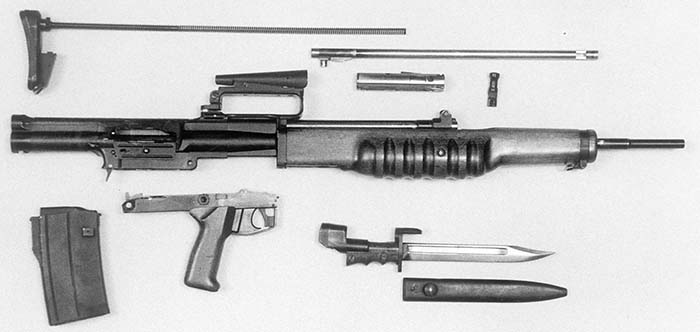
Trials and Tribulations
By autumn 1946, Britain, Canada and the USA shared a consensus around standardising their weapon systems, including infantry rifles. The advantages in terms of costs, interoperability and logistics were obvious. However, the British and Americans were in dispute about what constituted the optimum infantry weapon. The British wanted to introduce an assault rifle; the Americans favoured a more traditional battle rifle. Consequently it was decided to conduct a series of tests which not only compared prospective rifles, but also rounds of different calibre offered by the British and Americans. Initial tests lasted from February to April 1950. They compared three rifles, two of which used the British .280 round. These were the EM-2 and the Belgian FN Lightweight Automatic Rifle, both firing .280 ammunition. The USA fielded its T 25 rifle firing a full sized round, the T-65, of 7.62 mm calibre.
Test results were collated and the performance of both ammunition and weapons were assessed in a number of reports. These documents provide the basis of most appraisals of the EM-2. The most frequently quoted are the reports generated by tests conducted at Aberdeen Proving Ground. i ii The Aberdeen papers are included as part of the evaluation of the British Bullpups in Thomas Dugelby’s seminal book on the EM-2iii. The Aberdeen papers reflect the aims of the senior echelons of the US army and high-ranking representatives of industry and government. They were intent on purchasing a rifle designed and produced in the USA, and one which fired a full power round.iv However it is not commonly appreciated that there were splits within the US military. As far as some of the lower echelons of the US army were concerned, particularly amongst potential users of the new rifle, there was a more open minded approach. This is evident in the series of comprehensive user tests conducted at Fort Benning.v The British .280 round was examined with interest, although there were strong reservations about the EM-2, which was seen as too revolutionary a configuration.
As far as ammunition is concerned the Fort Benning report made the following judgments. “That the T-65 Cal .30 is not satisfactory because of its excessive recoil, blast, flash and smoke. That the Cal .280 is not satisfactory because of its comparatively high trajectory. That of the two basic types of rounds submitted for test the British caliber .280 is preferred.” (My italics).
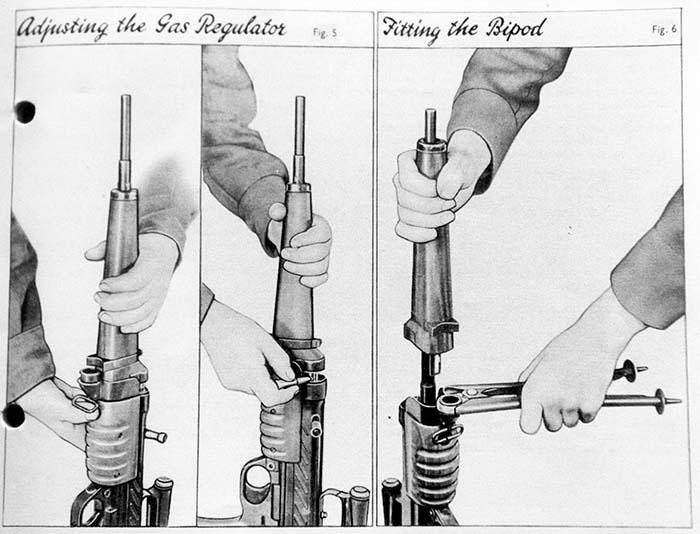
Despite Fort Benning’s relatively favourable review of the .280 round, the US army was determined that the stopping power of any cartridge adopted, should not be less than that fired by their standard infantry rifle the M1. In addition they wanted the round chosen to be the same calibre used by the squad machine gun.
As far as ammunition performance was concerned, a compilation of assessments from the various reports shows the following characteristics.
- The American round did have more stopping power, particularly below 1000 yards. Its greater velocity caused a larger transient wound cavity.
- As range increased the performance differential favoured the lighter round. At 1000 yards the .280 could defeat body armour 70% of the time, the .30 60% of the time. Over 1000 yards the .280 round had better penetrative power because of its superior ballistic coefficient.
- The T-65 had a flatter trajectory than the .280 and consequently had superior accuracy below 1000 yards.
- At ranges over 1000 yards, the better stability of the British round ensured greater accuracy.
- The .280 round had considerably less flash and smoke, allowing a reduced firing signature.
- The .280 did not have a viable armour piercing round, however, its tracer round was better than that of the T-65.
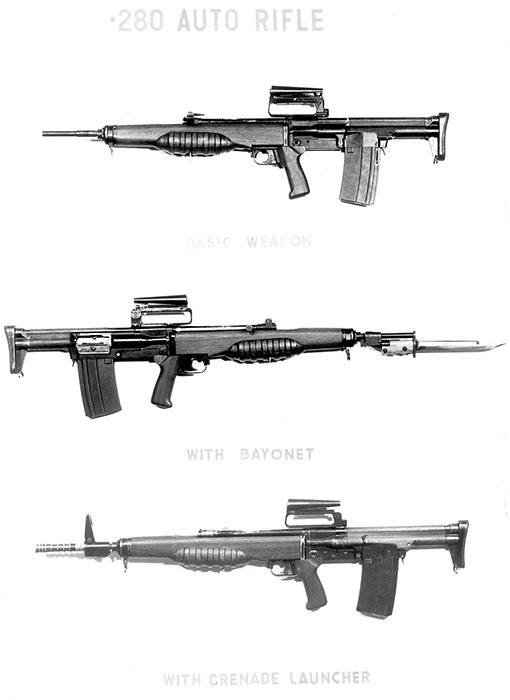
All of the rifles subject to test had their own advantages and disadvantages:
- The T-25 was more accurate than its competitors when fired on semi-automatic. This was a significant advantage, although Fort Benning’s tests showed less of a differential than those conducted at Aberdeen Proving Ground. Fired from the prone position, without a bipod, the mean radius was as follows. At targets 200 yards distance, at a rate of 19 rounds a minute, the result for the EM-2 was 0.57 ft, that for the FN 0.54 ft and for the T-25 0.44 ft.
- In terms of hits per minute, the EM-2 was slightly superior to the FN and far better than the T-25, when fired on full automatic without a bipod. With a bipod, the T-25 was the best.
- As far as the effect on firers, all the rifles had shortcomings. The T-25 was most problematical. Its recoil and the noise of firing were considered unacceptable. The FN’s stock was considered too short to fire without discomfort. In the case of the EM-2 occasionally particles of unburned powder hit the firer in the face.
- General reliability in field conditions didn’t meet service requirements; however figures showed the FN to be best followed by the T-25 then by the EM-2.
- When subject to hard usage tests under abnormal conditions, the EM-2 was the most durable.
- Field maintenance was easiest with the FN, then EM-2 and finally the T-25.
In Fort Benning’s final assessment of the rifles’ performance, the following points were made. “That none of the three test rifles is acceptable in its present form. That the FN will be acceptable for comparatively early use when modified in accordance with Appendix E. That the EM-2 and T-25 require considerable further development and are not acceptable in their present form. Of these two the EM-2 is preferred.”
Both the US and Britain made efforts to improve their favoured ammunition. The US introduced an improved T-65 cartridge, which became the 7.62 mm round adopted by NATO. The British developed a 7 x 51 mm higher velocity version of the .280 round which answered some of their problems around high trajectory and round dispersion. Unfortunately the US was adamant; they wanted the increased stopping power of the heavier round.
As part of attempts to keep the EM-2 in the running, examples were modified to 7.62 mm calibre. The modified rifle worked well enough with the new calibre, except on full automatic, when like all other 7.62 mm weapons, it proved too difficult to fire sustained bursts accurately. However, the EM-2 had been designed from the onset as a lightweight, selective fire assault rifle firing an intermediate round, rather than a battle rifle firing heavier calibre ammunition. Its best qualities were diminished and its complexity and faults exposed.
In the event after trials in mid 1952, the USA decided to choose between just two rifles. The first, a modified FN rifle firing 7.62 mm which it designated as the T48 and the second the T44, a product improved M1 self-loading rifle. The latter rifle won, leading to a weapon known to history as the M14.
As for the EM-2, its future proved bleak, particularly after Britain’s government changed and the weapon lost political support. Churchill, re-elected as Prime minister, thought the weapon unsoldierly, unsuited for both bayonet fighting and for drill. In any case, the urgent need to have commonality with whatever round and rifle NATO decided upon was paramount.
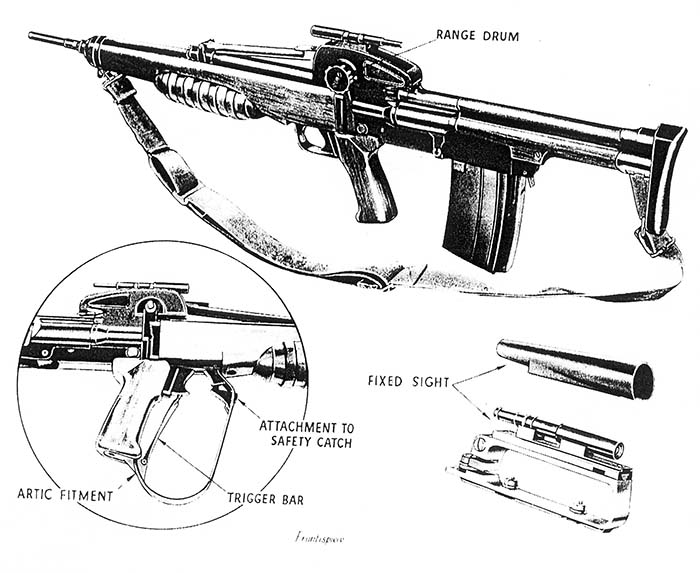
Conclusion
Should the EM-2 been given a production contract? It certainly came close; at one stage it was given the service designation Rifle No 9. A designation later rescinded and given to an experimental Enfield SMLE No 4 re-bored to .22 calibre. The EM-2 did have faults. The ammunition needed further development, and in addition the weapon’s accuracy needed improving. These difficulties were not insurmountable.
In truth the trial FN was not significantly better than the EM-2. Yet, given time and money for further development, the FN metamorphosed into a fine battle rifle. The FN had the advantage of a relatively simple mechanism and traditional configuration. It was easier for industry to tool up for production and for the military to adopt. It is possible that the EM-2 could have been turned into the finished article. However this would have required both money and time, two commodities the British didn’t have. Perhaps the best option technically would have been for Britain to adopt the FN in .280. However, the bottom line was that the British could not afford to develop an infantry weapon with a different calibre to that used by the USA. The Korean War meant that Britain needed a new battle rifle as rapidly as possible. The need for standardisation and to maximise production held sway. Consequently the Bullpups and the .280 round were ditched.
Both the UK and USA adopted a new rifle and calibre on economic and political grounds rather than that of technical superiority. The British adopted the FN, a Belgium rifle that fired an American designed 7.62 mm x 51mm round. Despite the British abandoning their ambitions for a national design in the interests of NATO unity, the USA did not show any reciprocity. It fielded the M14 rather than the FN adopted by the bulk of the Western alliance.
Ironically, in the future it would be the Americans who eventually forced through an immediate round of sorts, the 5.56 mm. This was done in the teeth of initial reluctance by its allies and even elements of the US military.
- i A comparison of United Kingdom and United States lightweight rifles. Tenth report of project NO. TS2-2015, 16th February 1950 to 28th April. Aberdeen Proving Ground.
- ii A comparison test of United Kingdom and United States ammunition for lightweight rifles. Ninth report of Project TS2-2015. 14th February 1950. Aberdeen Proving Ground.
- iii Dugleby, Thomas. 1980. EM-2 Concept & Design. Collector Grade Publications. Toronto. Canada.
- iv Conference of Defense Ministers. United Kingdom, France, Canada, United States on Small Arms Standardisation. 2-3 August 1951.
- v Report of the Army Field Forces Board N03.Fort Benning, Georgia. Project No 2231. Report of Joint Test of United States and United Kingdom Lightweight Rifles. October 1950.
The author would like to thank Rob Sharrock, Richard Jones, Rod and other staff at the Royal Armouries and Pattern Room at Leeds for their help and assistance. Thanks also to Ian Patrick for his advice.
| This article first appeared in Small Arms Review V6N2 (November 2002) |












